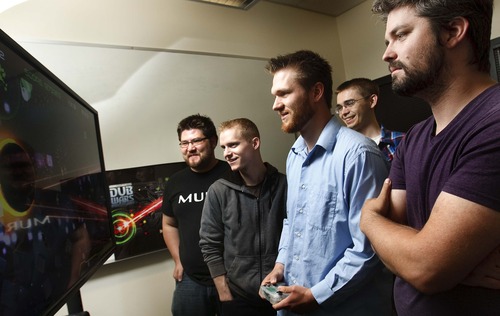This is an archived article that was published on sltrib.com in 2013, and information in the article may be outdated. It is provided only for personal research purposes and may not be reprinted.
What started out as a joke during a brainstorming session turned into an out-of-the-gate success for four young video game developers from Utah Valley University.
The five soon-to-be seniors in digital media who formed the company MURA Interactive have created "DubWars," a fast-paced shooting game that plays to the rhythms of dubstep songs, the popular genre of electronic music. Even before the game has been released, it already has caught the attention of companies.
A demo of the game was included with the launch of the new independent video game console called OUYA, which was released in stores earlier this month. "DubWars" also was used at last month's big E3 video game trade show in Los Angeles to show off a new game controller for video game accessories manufacturer Nyko. Finally, the team also has a successful Kickstarter campaign that ends later this week to help fund the completion of the game.
Earlier this year, MURA, which is comprised of students Joe Albrethsen, 28, Michael Chugg, 25, Sam Sawyer, 27, Evan Phillips, 26, and Ben Hale, 25, were trying to come up with the idea for their first video game.
"We all pitched about 10 different ideas," said Albrethsen, the team manager. "Then Sam pitched [as a joke] that we should make a game for dubstep music. We all laughed and moved on to other games."
The team decided on another idea for the game but it didn't ignite their imaginations.
"I said, 'Screw it, let's make the dubstep one,' and everybody cheered, and that's how 'DubWars' got its start," Albrethsen said.
"DubWars" is a single-player overhead shooting game in which the player controls a neon-colored ship and shoots tiny robots that spark from a circuit board. While the player controls the ship's movement and aim, the guns automatically fire to the beat of the music.
"We actually go in and hand-animate and customize each level to the song," Albrethsen said. "When the bass drops, big lasers and all kinds of effects happen."
In just a few months, MURA delivered a demo of the game that includes four levels and four songs. That small slice of the game was picked up by the makers of OUYA to be included with their video game console. OUYA is a small $99 console that runs on the Android operating system and is hooked up to a television and played with a gamepad controller.
The "DubWars" demo is available for free on the Ouya as well as for the PC and Mac computers. Meanwhile, MURA is taking $15 pre-orders for the full version of the game, which is expected to launch next summer.
To help fund the game, the team also started a Kickstarter project and already met its $30,000 goal. With that, the team will make more levels and license more songs, possibly implement more gameplay ideas, and develop it for other gaming platforms including Android tablets and phones as well as the iPhone and iPad.
"We are looking at the possibility of doing multiplayer but we haven't found a clever way to do it yet," Chugg said.
The Orem university's video game curriculum in the digital media department is only a few years old. The team is the department's "pilot group" and the first to develop a game from start to finish for sale, said UVU digital media professor Rodayne Esmay.
"If I could model a group. . .for other students coming into the program, I would with this group," he said. "They deserve everything they have accomplished."
Video game development and computer animation have become regular curriculums in many universities around the country with the popularity of gaming, which last year generated more than $13 billion in hardware and software sales, according to the NPD Group.
Brigham Young University has created one of the most renowned computer animation departments while the University of Utah's Entertainment Arts and Engineering program was recently ranked the best undergraduate gaming program in the country, according to The Princeton Review and PC Gamer magazine.
"Seventy-four percent of the video game development industry is in the U.S.," Esmay said. "It's a huge export for the U.S. People don't recognize that, and other countries are seeking to catch up."



